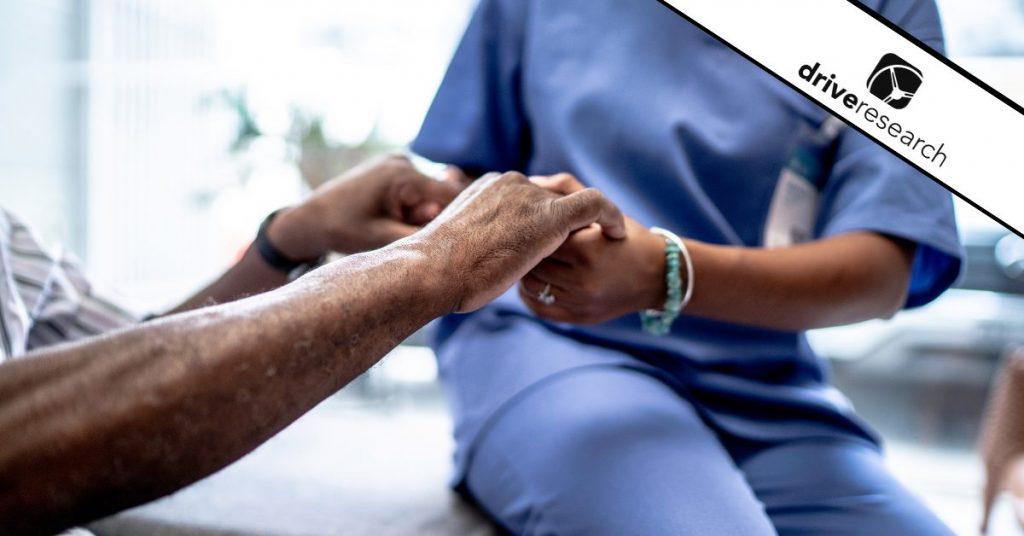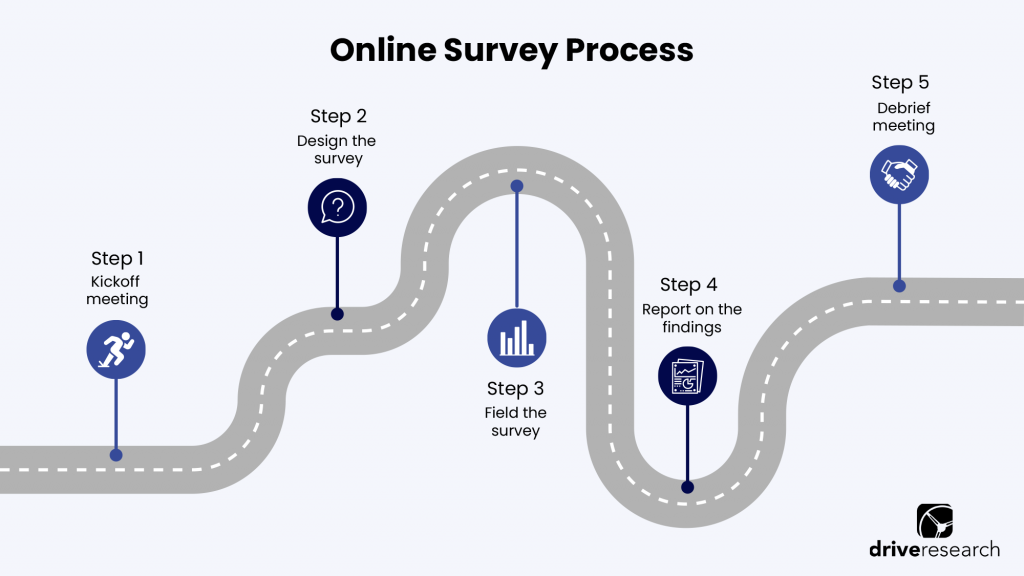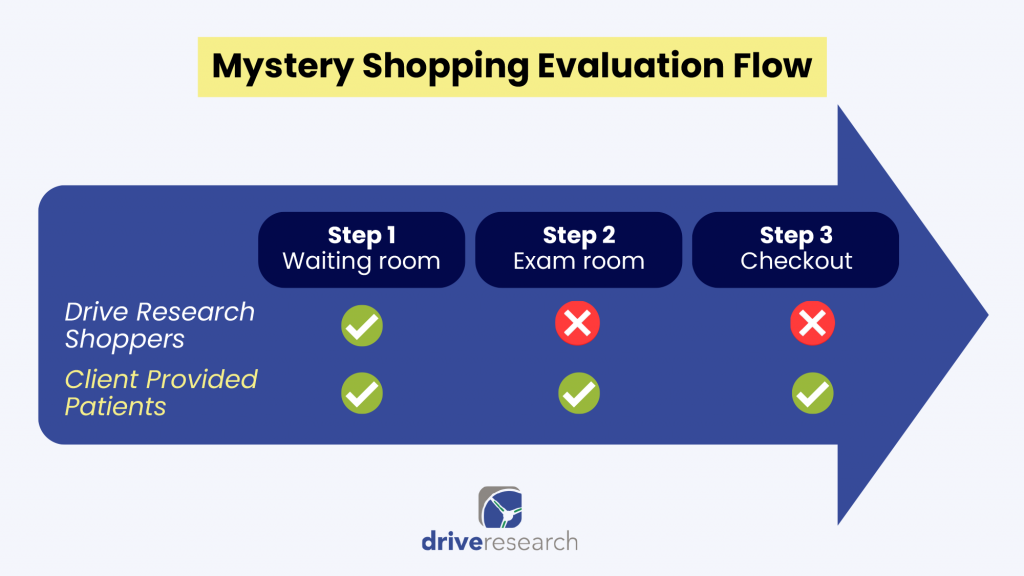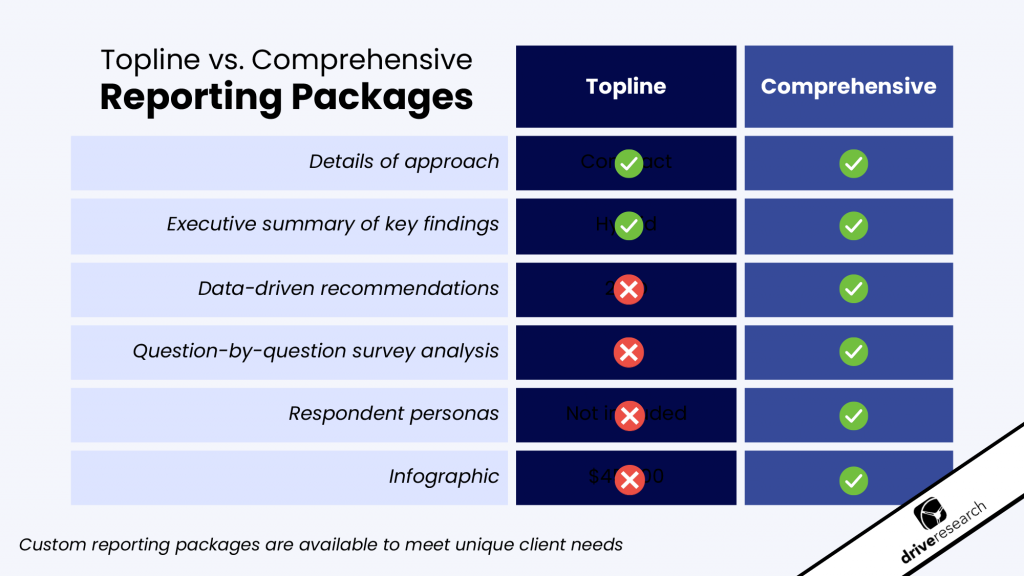
When it comes to healthcare market research options, most facilities and providers are primarily interested in conducting patient experience surveys or mystery shops.
Both types of market research are valuable in understanding what your healthcare center is doing well and what areas can be improved.
Although, depending on your goals, timeline, and budget there are times when patient satisfaction surveys make more sense than healthcare mystery shopping – and vice versa. To help you decide, our healthcare market research company dives into each methodology, explaining their benefits and the step-by-step process to complete them.
Patient Experience Surveys
Let’s start with a basic definition.
A patient experience survey is a questionnaire filled out by healthcare patients following a medical visit to gauge their satisfaction.
This survey can touch on various topics such as:
- Quality of care
- Facility standards
- Friendliness of the team
- Wait times
- Scheduling appointments
The patient experience survey is customized based on your practice and objectives.
For instance, according to these patient satisfaction statistics, 59% of millennials say they would switch doctors if it meant better online access.
Perhaps, your custom survey then dives into your online appointment portal to determine if it satisfies your patients.
When to use patient experience surveys
If your practice or facility is looking for feedback on straightforward, easy-to-remember metrics, a patient experience survey is great!
Patient surveys can also evaluate the entire experience from reception, exam room, to check-out.
They can also cover other factors such as:
- How they first learned about your facility
- Factor(s) in choice for medical care
- How you compare to competitors
Recommended Reading: Benefits of Measuring Patient Satisfaction with Surveys
How to Conduct Healthcare Satisfaction Surveys
A patient experience survey follows a similar process to any online survey.
However, there are different stipulations because sharing personal identifying information is more sensitive in healthcare studies.
Though, generally speaking, the patient experience survey process includes the following steps:

1. Sign a market research proposal
Sent by the research firm completing the project, the proposal will include highlights such as process, approach, and cost.
2. Attend a kickoff meeting
Kickoff meetings are a critical first step to a successful research project.
Serving as an information-sharing session for both the research firm and the client, information covered during this call includes:
- Objectives of the research
- How the results of the research will be used
- Timelines
- Process overview
- Deliverables
- Next steps
3. Drafting the survey
Patient experience surveys are drafted in a Google doc. It is customized based on the unique goals and objectives of the healthcare facility or provider.
Some common sections include:
- Location(s) visited
- Reason for visiting
- Reception/waiting area
- Check-in process
- Examination room
- Checkout process
- Invoice/billing process
We’ll share more specific examples of patient experience survey questions in the next section.
4. Begin compiling patient lists
PII is needed to conduct patient satisfaction surveys.
The necessary information can differ depending on objectives, target mixes, etc.
At a minimum, first name and email are needed to launch an email campaign for the study.
Though, some clients also choose to filter out those with more sensitive/critical reasons for seeking care due to the sensitivity of the visit.
5. Sending the pre-notice to patients
For patients, the pre-notice is a required step to complete the project.
Receiving a pre-notice from a verified contact (i.e., one from your organization) benefits the research for reasons such as:
- Adds credibility to the third-party research firm
- Alerts patients to be on the lookout for the survey, therefore boosting response rates
- Relays to patients that their personal information is secure and will remain anonymous
The pre-notice should be sent a few days before the survey campaign is launched.
Here is an example pre-notice to send before launching the patient experience survey.
Subject Line: Upcoming Patient Experience Survey for [client]
As our continual commitment to fast and affordable urgent and primary medical care, we have recently contracted with an independent mystery shopping firm. [client] is working with Drive Research, an independent market research company, to conduct an important patient experience survey.
Within the next week, the market research company will email you a short [length of survey] survey to request feedback. Your feedback will provide relevant insights to help us ensure patients receive the utmost quality of care, and the patient experience is consistent for the [client] brand.
We truly want to hear from everyone, and it is important to know your responses will remain confidential with Drive Research. At no time will your personal information be tied to survey responses, and you will not be asked any questions about your own health status or personal health issues.
I want to thank you in advance for your participation in this upcoming survey. The invitation will come from Drive Research with the subject line, “[client] Needs Your Feedback”.
If you have any questions about the survey, feel free to reach out to our team by contacting [Insert contact and contact information].
For ongoing patient experience survey campaigns, an opt-in may be added to the check-in or check-out process.
Though, regardless if these opt-ins are implemented, we recommend a pre-notice be sent to patients.
6. Data collection
Once all the setup is out of the way, the fun part can begin!
Data collection works differently depending on the method you choose.
For patient experience surveys, this usually starts with launching an email campaign to patient contacts provided by the client.
The initial email invitation to the patient experience survey is generally followed up with 2-3 emailed reminders, and clients may choose to opt for follow-up phone calls to non-responding patient contacts.
7. Reporting
Once data collection is complete, we are able to begin compiling the market research report.
The contents of the report will depend on the objectives shared and the package selected.
For instance, a topline report may only include an executive summary and key findings from the study.
While, a comprehensive report will include these components, plus expert recommendations, infographics, analysis of question-by-question results, and more.
Clients may choose to forgo the report and receive only the data from the research.
Recommended Reading: Topline or Comprehensive Market Research Report – What’s the Difference?
Example Patient Experience Survey Questions
Again, patient experience surveys are also customized in order to meet your specific objectives.
They can include all example questions below, as well as cover the additional steps that mystery shoppers are typically unable to complete.
Here are 15+ patient experience survey questions our healthcare market research company recommends including.
- Please enter the approximate time you entered the exam room. Enter a time in the HH:MM AM/PM format below.
- Please enter the approximate time the provider entered the exam room. Enter a time in the HH:MM AM/PM format below.
- What was the name of the medical assistant (not the provider) you spoke with? Select one from the dropdown menu.
- [If “none of the above’ was selected] What was the name of the medical assistant you spoke with? Enter response.
- What was the name of the provider you spoke with? Select one from the dropdown menu.
- [If “none of the above’ selected] What was the name of the provider you spoke with? Enter response.
- Please confirm which of the following you observed while in the exam room. Select observed, not observed, or do not recall for each.
- Please rate the medical assistant on the following attributes.
- For [insert factor], you gave the medical assistant a lower rating. Why? Enter response.
- Please rate the provider on the following attributes. Select one for each. [Randomize rows]
- For [insert factor], you gave the provider a lower rating. Why? Enter response.
- Please share anything else about the exam room area that you feel was not covered or could be improved. Enter response.
- Please enter the approximate time you received your visit summary. Enter a time in the HH:MM AM/PM format below.
- Did a member of the staff review the visit summary with you? Select one.
- Was anything unclear about your visit?
- [If “yes] Was the staff member able to address any unclarity? Select one.
- [If “no”] Why was the staff member not able to address any unclarity? Enter response.
Healthcare Mystery Shops
Healthcare mystery shopping involves sending a trained shopper (masked as a patient) into a medical facility with a pre-written form and directions for who and what to evaluate.
An established evaluation form is helpful for mystery patients because they will uncover the right information, rather than relying on memory such as from a patient survey.
Mystery shopping can cover similar topics to patient surveys.
However, the study is typically done by a third-party mystery shopping company, with the objective to evaluate, rather than receive care when done in the medical realm.
When to use patient mystery shops
Mystery shopping should be used when you are intending to evaluate specific criteria.
Shoppers arrive at the location to seek out this information, rather than a patient survey that evaluates the entire experience after the fact.
Who acts as the mystery patients?
Medical mystery shops are typically completed by non-patients.
These non-patient mystery shoppers are able to evaluate up until the point where they are required to share personally identifiable information (PII) such as:
- Contact information
- Health insurance information
- Payment information
- Information about their own health status
This is to protect the privacy of the mystery shopper, along with avoiding permanent information being entered into their personal health records or submitted to their insurance company.

Because patients have a valid reason for visiting, they are able to evaluate the full experience including examination, interactions with a healthcare professional, checkout, and billing.
However, asking specific questions about their own health concerns or issues should be avoided.
How to Conduct Healthcare Mystery Shops
The first few stages of healthcare mystery shopping follow that of a patient experience survey.
As referenced above, all market research studies will start with a signed market research proposal and a kick-off meeting.
The next steps of patient mystery shops slightly differ from patient surveys.
Here’s how.
1. Draft a mystery shop evaluation form
The contents of the evaluation form will vary depending on your core objectives.
When conducting a mystery shopping program, it is also important to pre-determine a list of scenarios for shoppers to use.
These scenarios should be non-invasive and applicable to nearly anyone.
For example, it’s much easier for a mystery shopper to tell front-desk staff they are experiencing a sore throat than being concerned they have a broken limb.
Potential mystery shopping scenarios can include:
- Allergy treatment plan
- Seeking a new primary care provider (PCP)
- COVID-19 testing
- Mental health – seeking a psychological diagnosis
- Urgent care – cold/flu symptoms
- Pre-employment clearance
- Prescription refill
2. Secure staff to complete the mystery shops
Once the location(s) of the research study has been finalized, and the survey or evaluation form is underway, you can begin securing “the who” for the project.
For patient mystery shopping projects, it is important to know how many visits per location, as well as potential staff work locations.
If there is a chance that some or all staff may be working at more than one location, you’ll want to share this with the mystery shopping company to ensure there is no overlap and maintain the secrecy of the program.
3. Sending the pre-notice to employees
For patient mystery shopping projects, a pre-notice is an optional notice sent to staff by their employer to alert them of the potential they may be mystery shopped.
Our healthcare market research company leaves this decision in our client’s hands as sending the pre-notice can have implications for the mystery shops.
Staff may be on their best behavior while the mystery shopping campaign is active, essentially sugarcoating the data collection.
On the other hand, keeping your team in the loop that these campaigns are upcoming can eliminate the chance staff may feel blindsided by the event.
This notice should be sent in advance of the mystery shopping campaign and include high-level information about:
- Objectives
- Timeline
- Location
- Company contact they can reach out to with any questions
Here is an example pre-notice to send to employees.
Subject: Upcoming Mystery Shopping Campaign for [Client company]
To Our Valued Employees,
As our continual commitment to fast and affordable medical care, we have recently contracted with an independent mystery shopping firm. This consultant will help us measure key performance indicators at all our locations to ensure patients receive the utmost quality of care and the patient experience is consistent for the [client] brand.
Each month the firm will be sending mystery shoppers to [client] locations on a variety of days. They will evaluate each [client] location and staff based on a number of factors including front desk interactions, cleanliness of the location, and the provider staff. This feedback will be invaluable to our management team to help us continually improve.
The mystery shopping program will begin in [Insert start month]. You as an employee, do not need to take any action from this notice. Please contact [Insert contact at client company] if you have any questions or concerns!
4. Data collection
Again, data collection works differently depending on the method you choose.
For mystery shops, this includes deploying mystery shoppers to the locations if in-person research is chosen. If the client opts to evaluate through customized phone calls to care locations, those can begin.
Mystery shoppers are directed to complete an online evaluation form immediately following the engagement in a private location.
5. Reporting
Similar to patient experience surveys, reporting the findings for healthcare mystery shops will vary. The most common reporting packages are toplines and comprehensive market research reports.

Example Patient Mystery Shopping Evaluation Questions
Evaluation forms are customized in order to meet the client’s objectives, but example patient mystery shopping questions that can be included are below:
- Enter your first and last name. Enter response.
- Enter the date of the mystery shop. Select a date below.
- Enter the approximate time you entered the location. Enter a time in the HH:MM AM/PM format below.
- Which of the following locations did you mystery shop? Select one. [Insert list of client locations]
- You completed this mystery shop at the [company name] located at [insert Q.4 response]. Is that correct? Select yes or no.
- [If “no” selected] Please select the “back” button below to select the correct address of the mystery shopping location.
- [If “yes” selected] Please refer to your experience at [Location] for the remainder of the evaluation.
- Which of the following scenarios did you use for this mystery shop? Select one. [Insert list of mystery shopping scenarios]
- Please enter the approximate time you first interacted with a front-desk staff member. Enter a time in the HH:MM AM/PM format below.
- Please select the name(s) of the front-desk staff member(s) you spoke with. Select all that apply. [Insert staff list]
- At the time of your mystery shop, what was the estimated wait time to be seen by a provider? Enter response.
- Please confirm which of the following attributes you observed while in the reception/waiting area.
- Please rate the front-desk staff on the following attributes.
- Based on this experience, how likely would you be to recommend [client] to a friend or family member seeking medical care? Select one.
- You indicated your likelihood to recommend as a [insert rating] out of 10. Why is that? Enter response.
- Overall, how well did [client] perform for each of the following? Select ratings from not at well to extremely well.
- For [insert factor], you gave a lower rating. Why? Enter response.
- If you had to summarize your patient experience visit today, what word or phrase would you use? Enter response.
- Please share anything else about your visit that you feel was not covered or could be improved. Enter response.
Final Thoughts: Patient Surveys vs. Mystery Shops
There is no definitive answer to which healthcare market research methodology is the best. When choosing between patient experience surveys and mystery shopping, it is best to think about your objectives, timeline, and budget.
For instance, if you are looking to go more in-depth on various metrics, a mystery shop may be better suited to meet your needs. Although mystery shops will take longer to execute and are often more expensive.
However, if you are looking for a high number of responses, a patient survey may be best. Typically, mystery shoppers can only evaluate a location one time (unless there is a large window in-between) to avoid any staff suspicion.
Contact a healthcare market research company, like Drive Research. Our team can share the best course of action depending on your project’s specifics.
Contact Our Healthcare Market Research Company
Drive Research is a full-service market research company. Our team has managed both medical mystery shopping campaigns and patient satisfaction surveys for clients across the U.S.
Interested in learning more about where we can help? Contact us today.



